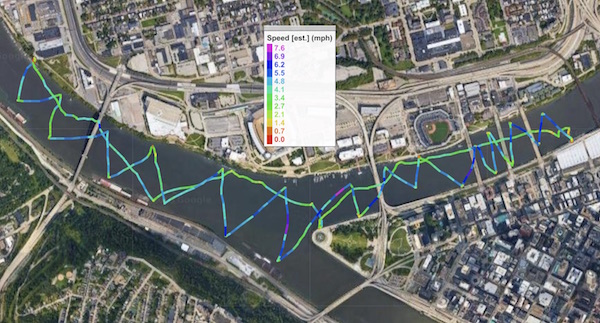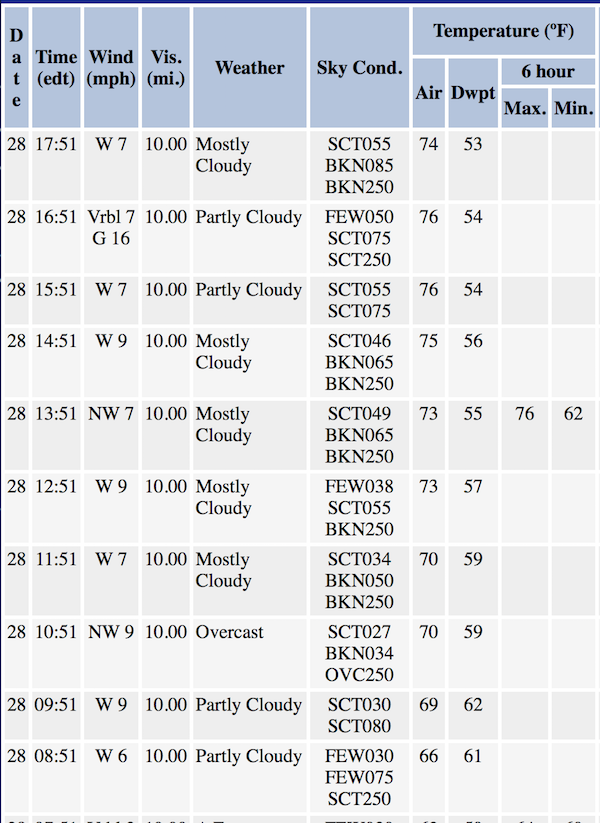First Sail
July 28, 2018
Now that my little sailboat was set up at the water's edge at the Newport marina a little over a mile downstream of the Point, all I needed were the right conditions to set off on my first sail of the summer.
It's a waiting game. I need winds strong enough to sail in but not so strong that they overpower the boat. They cannot blow in just any direction. The high bluff on the southern bank of the Ohio and Mon rivers effectively blocks winds blowing from the Southwest and thereabouts. Unfortunately these are the most common winds in the summer.
Finally, today on July 28 it all came together. For several days the National Weather Service had been predicting steady Northwesterly winds at around 7 and 8 mph for the afternoon. Those winds blow unobstructed along the Ohio River valley and make for steady, plain sailing.
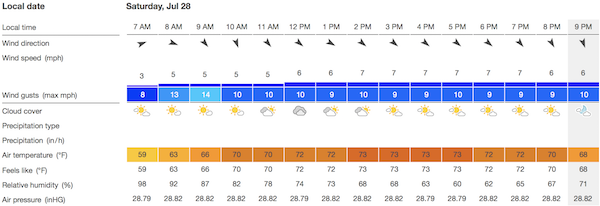
click for larger
Click for National Weather Service graphical forecast.
7 to 8 mph? That's my sweet spot. Not too strong and not too weak.
The other factor to check is the currents on the rivers. The river currents had been unmanageably high after strong rainstorms earlier in the summer. The flow today on the Ohio was a quite manageable 15,800 cubic feet per second.
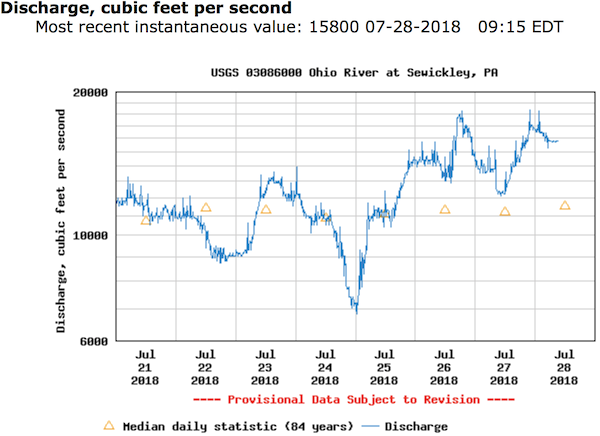
The flow on the Mon was too low to worry about, 2700 cubic feet per second:
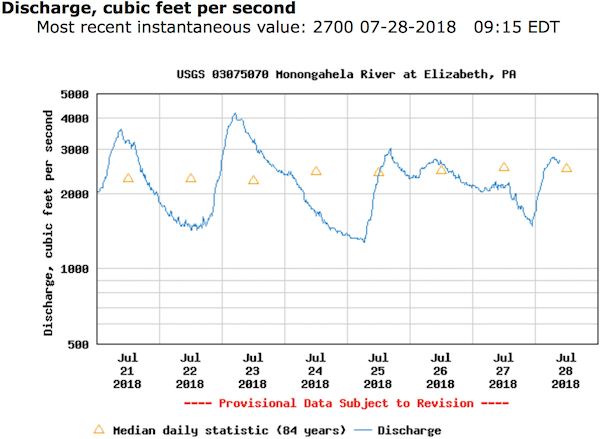
However the flow on the Allegheny was a little worrisome. It wasn't the number, 12500. It was that the flow was rising. Would it continue? Or would it stop its climb and reverse?
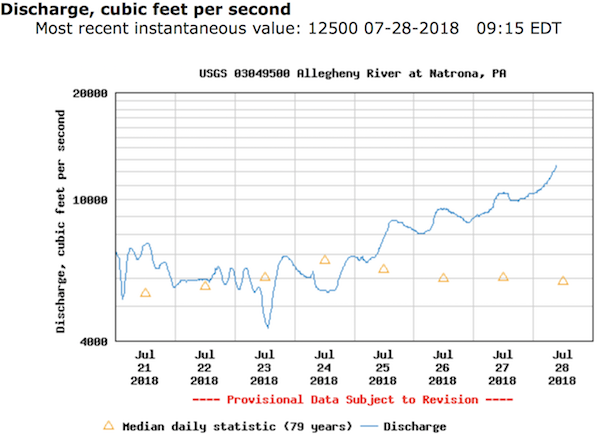
I decided to go ahead and sail. Winds from the Northwest blow against the current. That is the best case, since they blow me upstream, making it easy to overcome a slight current. After I'd sailed, I checked the current again. It had stopped its climb and turned during the time of my sail:
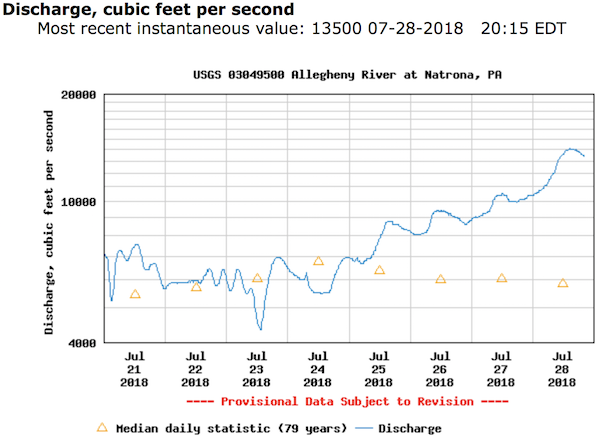
I did not then know that this would happen when I set off on my bike a little before 2pm. I was burdened with all my gear: a gps receiver, camera, wind gauge and more. I wear a life jacket and know that I look someone of an oddball. But how else can I get all my stuff to the boat?
The ride took me along the banks of the rivers on which I will sail. It was a perfect way to check conditions first hand.
Crossing the 7th Street Bridge, I measured a serviceable breeze of around 3-4 mph blowing upstream. That was good. Northwesterly winds have to turn the corner at the Point if they are to make it up the Allegheny. I did not expect much wind at this bridge, but I was happy to see it.
There was a lot of activity on the rivers and their banks. It is a pleasant summer day and the rivers are the perfect place to walk, or run, or bike, or stroll. There will be a baseball game later in the day. That draws in more people.
The banks are a favorite spot for wedding photographers. Theirs is not an easy job. They have to deal with cyclists like me riding straight through the middle of their shoots.
"You have a tough job," I called out to the photographer as I biked past. "Not so hard," he replied--or something like it.
I was more interested in the winds on the river, however. They were mild. I measured them to be around 2-4 mph. That would enable a restful sail. I'd hoped for more. I could see the plume of the fountain at the Point over the kayakers. It was high, suggesting mild wind. The flow and plume height drops when the wind is stronger.
Soon I was at the Newport marina. The winds there were disappointing. They were blowing from the Northwest against the current as forecast. But they were meeker than the 7 mph predicted. I measured winds still in the 2-4 mph range. The good news was that I could discern little or no current from tracking the debris in the water. This much wind would be enough to get me to the Point.
My sailboat was waiting at the river's edge. The rain had filled its protective tarpaulin with water. It was like a small swimming pool.
Soon the mast was stepped and the boat rigged. I put into the water at about 2:30pm and headed off on a run towards the Point. "On a run" means that the wind was blowing from behind the boat, from its stern. The sail acts like a big bag that catches the wind and drives the boat forward. I like this point of sail the least, since I have least control of the boat. But progress is assured.
It felt like I made a slow start. But soon I noticed that I was making very good time. I approached the huge span of the West End Bridge...
...and soon passed under it. I think I'll never lose my sense of awe and wonder when these huge spans pass overhead. Many more will pass over me before the day's sailing is over.
There was a lot of activity on rivers. The Ducky boats were out in full force:
On the far bank, I could hear and see a train thundering along. For a while, the train and a Ducky boat moved neck and neck:
These sights distracted me from noticing that I was making very good time. I was maintaining a steady 4-5 mph for much of the sail to the Point. The winds must been even stronger since I could still feel some wind on my back as I sailed. As I passed the submarine at the Carnegie Science Center, I decided to sail in close to it for a better look:
Here's the gps track color coded for speed.
I set out from the Newport marina in the top left hand corner. The outward bound track is the straighter one. I'm on a run, so there's no need to tack to and fro.Speeds throughout the afternoon's sail were in the 3-5 mph range, sometimes less, sometimes more.
I reached the Point in good time at 2:50pm. It had been a pleasant 20 minute sail.
There was enough wind for me to go where I pleased. So why not sail in close and skim the edge of the Point? So I did and this is how it looked from the water:
There is no mooring allowed at the tip of the Point. Signs prominently warn against it and, more practically, there is nothing to tie a mooring line to. So I decided to keep going. At 2:55pm, I pointed my bows up the Allegheny.
With Northwesterly winds, sailing on the Allegheny can be difficult. The winds are blocked by the buildings on the Northern bank. However these winds were unobstructed. I could keep sailing on a run up the Allegheny.
What had happened was that the weather forecast of winds was, once again, a little off. The winds that arrived this afternoon were not Northwesterlies, but Westerly winds, blowing at around 7 mph.
Here's the National Weather Service log for the afternoon:
You'll see that the temperatures were very pleasant, hovering in the mid 70sF. With the blue sky and puffy white clouds, the conditions were perfect.
Onward--up the Allegheny.
Here I am sailing under the Fort Duquesne bridge. Here's a view shot blind from the water, over the side of the boat, and one looking up at the great span as it passes overhead:
With the winds blowing my way, it was just too tempting to sail on and on. So I did. I passed children playing in the fountain:
Boaters:
Kayakers:
Looking upstream toward the bridges at 6th, 7th and 9th Streets:
By 3:20pm, I was docked at the Convention Center.
It was a chance to stretch my legs and drink a little water. Looking further upstream I could see the rusty, gritty hulk of a much used railway bridge:
A train was crossing it:
Sailing in this little stretch of the river held hazards for small boats like my sailboat and, I presume, kayakers. The 9th Street bridge marks the end of the "no wake" zone that requires power boaters to keep their speed down, so that they don't create large wakes.
What many do, the moment they pass the 9th Street bridge, is to hit the throttle and roar off, kicking up a huge wake.
These waves then propagate out over the water and bounce off the banks. They can be, I'd guess, as much as a foot high. Since my deck is just a few inches off the water and my hull extends only a few inches into the water, they are significant. They leave my boat pitching and tossing. Good seamanship dictates that you turn the boat to take the waves bow first. If they come from the side--the "beam"--and the winds happen to be blowing unfavorably, that is enough to tip the boat.
I've tried often to get a photo of this effect. It's very hard to capture. Here you see my bows make a splash as they smack down into the water after climbing over some powerboater's wake.
Around the time that I entered this part of the river the winds
dropped a little. The sailing became slow. I found myself laboring
to work my way over to the Convention Center dock at the same time
as powerboats zoomed past, kicking up wakes. You can see my
struggles in the crooked path I followed to the dock.
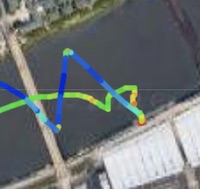
While docked, I could stretch my legs for a few minutes. Then, something I saw in the distance, made be want to put into the water immediately. For downstream, somewhere around the 7th Street bridge, I saw another sail!
It was the Noll's, the other party in our Downtown Sailing Club. I had to head off to greet them! So at 3:25 pm, I put into the water again and sailed off.
Now I was sailing into the wind. That meant that I needed to tack to and fro to make headway. This is sailing I enjoy much more than running with the wind behind me. I sit more comfortably on the deck and feel better in control.
The winds had freshened, so it seemed. I was able to sail quite quickly. The gps track shows stretches of 6 mph sailing. Soon I'd met up with the Nolls at the 7th Street bridge. Neither of us stopped. We sailed past each other, exchanging greetings.
You can see my flattened tacking as we passed back and forth in this detail from the gps tracks:
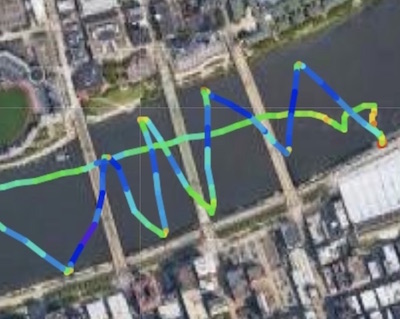
I'd been sailing for about an hour, at this point, and still had a long sail home. So, after a few passes back and forth, I apologized and called out that I had to head off home.
With that, I turned my bows to the Point and started to sail more closely to wind. There was still plenty to see on the way, including this curious addition to river traffic:
And this one:
The sailing was fast. The winds were blowing steadily up the Allegheny. I glanced up at the flag on PNC Park. It confirmed the direction:
The closer I came to the Point, the stronger the winds blew. At least once, they were strong enough for me to "fly a hull." A catamaran like my Hobie Bravo has two hulls. A hull "flies" when the boat tips over so far that one hull is out of the water. I needed to lean out over the side of the boat to keep things in balance. It is an exhilarating feeling, but a little risky. With a flying hull, I am just one little puff of wind away from the boat tipping over. So it is a little relief when the flying hull touches down again with an audible "slap" as it hits the water.
These stronger winds are reflected in the National Weather Service report above for "16:51" = 4:51pm. "Vrbl 7 G 16" = "variable 7 mph gusting to 16 mph."

That seemed quite right. There were stronger gusts exceeding 10 mph, sometimes sustained and sometimes strong enough to kick up small whitecaps on the water. These whitecaps form at about 15 mph.
Some of these moments of high speed were sustained enough to be recorded as the purple stretches in the gps track.

At 3:55pm I passed the Point and then began the long exercise of tacking into the wind to make it home to the Newport marina. Those efforts are recorded in the gps tracks as big, sweeping zig-zags. Close to home, I pass the barges docked on the far side of the river:
I sail in close. There is something fascinating about their enormity. Then I see the sign warning boaters to stay away. They carry a dangerous, flammable cargo. No lights. No smoking. So I turn away and sail into the marina, arriving at about 4:25 pm.
Sailing is wonderful. I love it. But these old bones grow sore and weary on the deck. Then there is no more welcoming sight than the marina and home:
With that work done, I head off home on my bicycle. As I pass the 7th Street Bridge, I see Rob and Olga Noll still out sailing. They dock momentarily and we exchange notes on the day's sailing. He had been caught "in irons" at the bridge pylons. That means that his bow points straight into the wind and cannot be turned away. I reply that I like the wind-sheltered "lees" downwind of the pylons. They are where my hard-to-tack Bravo can tack when the winds are blowing too hard.
Rob tells me that my Hobie Bravo "points" well. That is, he found that I could make much better headway into the wind than his boat could. But then I worry about how stable my Bravo is. His little boat, he tells me, can withstand 35 mph winds! He says if he floods the cockpit, the weight of the water makes it very stable. My Bravo is unhappy once the winds pass 15 mph.
John D. Norton
Back to main
